�

�
Murray Sinclair's Brabham BT29 Racecar
� ��
Owner: Murray Sinclair
�
City: Christchurch, New Zealand
�
Model: 1969 Brabham BT29
�
Engine: Ford FVA 16V DOHC four cylinder
�
Prepared by: Murray Sinclair and Rod Collingwood
�
Upgraded to Tasman Standards
��
Between 1969 and 1970, Motor Racing Developments built twenty-nine Brabham BT29s for North�
America's popular 1.6 liter Formula B racing class plus twenty-six Brabham BT30s for the�
international 1.6 liter Formula Two class. The two models were similar, but there were�
also very important differences: cylinder heads, fuel tanks, bodywork through the mid-section...�
and the Formula Two cars got wings! The BT29 we're featuring in this article was extensively�
modified during its original racing career and could possibly be mistaken for a BT30, but�
in fact it exhibits a different set of modifications.�
�
After a long and busy 1970 season of Formula B racing, this particular Brabham BT29 was�
shipped from U.S.A. to New Zealand to participate in the Tasman Series. Over forty years later,�
it has finally returned. In 2011, Murray Sinclair brought BT29-23 back to the United States�
to participate in two back-to-back vintage race weekends. We met Murray at the Watkins Glen�
Vintage Grand Prix, and learned about his car's history. We'll tell that story here.�
With photos and captions we'll document interesting details of his Brabham BT29's original�
design and of its subsequent modifications.�
�
�
�

�
MOTOR RACING DEVELOPMENTS LTD
�
Byfleet Road, New Haw, Weybridge, Surrey, England.
�
Chassis Number BT 29-23
�
Race Results in 1970 and 1971
��
Fred Opert imported BT29-23 for a young driver named Evan L. Noyes Jr. of Indianapolis,�
who drove it throughout the 1970 Formula B season in U.S. and Canada. Like all competitive�
Formula Two cars of its era, Noyes' BT29 was equipped with a 1.6L Lotus Twin-Cam engine.�
Noyes placed second in the 1970 SCCA Central Division Formula B championship and was the�
Formula B class runner-up at the 1970 American Road Race of Champions. Representing Fred Opert�
Racing and wearing race number 72 atop a flashy blue paint scheme, Noyes also entered every�
round of SCCA's professional 1970 Continental Championship series.�
�
Evan Noyes / 1970 SCCA Continental Championship for Formula B
�| Date | Race Name | Venue | Results | Comments | |
| 4/19 | (round 1) | Riverside CA | 21st of 35 | ||
| 5/24 | (round 2) | Edmonton AB | 5th of 11 | ||
| 6/7 | (round 3) | Seattle WA | 17th of 28 | (retired) | |
| 6/14 | (round 4) | Laguna Seca CA | 21st of 33 | ||
| 6/28 | (round 5) | Sears Point CA | 7th of 31 | ||
| 7/5 | (round 6) | Dallas Intl. TX | ? | (not classified) | |
| 7/18 | (round 7) | Elkhart Lake WI | 22nd of 42 | ||
| 8/1 | (round 8) | Mont-Tremblant QC | 12th of 33 | ||
| 8/16 | (round 9) | Brainerd MN | 4th of 24 | ||
| 9/7 | (round 10) | Lime Rock CT | 23rd of 29 | (stalled) | |
| 9/13 | (round 11) | Mosport Park ON | 16th of 25 | ||
| 9/27 | (round 12) | Mid-Ohio OH | 29th of 32 | (shunt) | |
| 10/25 | (round 13) | Sebring FL | 17th of 22 | (retired) | |
�
After racing in the northern hemisphere wound down for winter, Evan Noyes decided to travel to�
New Zealand and race in The Tasman Series. At that time, the series grouped two classes of cars�
together in hour long, hundred mile races. The two classes were (1) Formula 5000 cars which ran�
"production engines" up to five liters and (2) typically lighter weight racecars featuring�
"racing engines" up to two-liters.�
�
For the Tasman Series, Noyes' BT29 was updated with a 1.85L Cosworth FVC engine. The FVC was a�
newer, stroked version of the Cosworth FVA (1598cc) engine which dominated Formula Two racing,�
as supplied in Brabham's BT30 model racecars. The FV cylinder head design is one generation more�
sophisticated than the usual Formula B spec "Twin Cam" engine. The FVA and FVC also featured�
state-of-the-art fuel injection and electronic ignition.�
�
Even with such a sophisticated engine, the three liter displacement gap meant Noyes' BT29�
wouldn't be one of the quickest cars in the field. On the other hand, the attrition rate�
of the Formula 5000 cars was often high. Also, the smaller and more fuel efficient engine�
meant the BT29 would complete races without stopping to refuel whereas five liter cars�
would have to make pit-stops.�
�
Noyes also installed Brabham BT30 style (i.e. Formula Two spec) front and rear wings. �
�
Evan Noyes / 1971 Tasman Series
�| Date | Race Name | Venue | Results | Comments | |
| 1/2 | 12th Levin Intl. | Levin NZ | 8th of 14 | ||
| 1/9 | 18th New Zealand GP | Pukekohe NZ | DNF | (tire puncture) | |
| 1/16 | 20th Lady Wigram Trophy | Wigram Airfield NZ | DNF | (out of fuel) | |
| 1/23 | 14th Teretonga Intl. | Teretonga Park NZ | 8th of 11 | ||
| 2/14 | Warwick Farm 100 | Warwick Farm AU | DNF | ||
| 2/21 | Sandown Park Cup | Sandown AU | DNA | ||
| 2/28 | Surfer's Paradise 100 | Surfer's Paradise AU | DNA | ||
�
After contesting the first four races of the 1971 Tasman series, Evan Noyes loaned his�
Brabham BT29 to New Zealand racing star Graeme Lawrence for one weekend. Lawrence used it�
to place second in a Gold Star Championship race at Timaru on January 30, 1971.�
With that race, Lawrence clinched his title in the series. (Lawrence's usual car up to�
that point had been Chris Amon's old Ferrari 246T.)�
�
Noyes and Lawrence then traveled to Warwick Farm in Australia to contest round five of the�
Tasman Series. Neither racer finished the Warwich Farm race, and Noyes decided to call it�
quits. Instead of taking his BT29 home with him, he sold it to Lawrence. Though it hadn't�
been a particularly successful trip, Noyes must have had fun because he returned for the�
1972 Tasman series to campaign a Chevy powered McLaren M18 Formula 5000 car.�
�
�
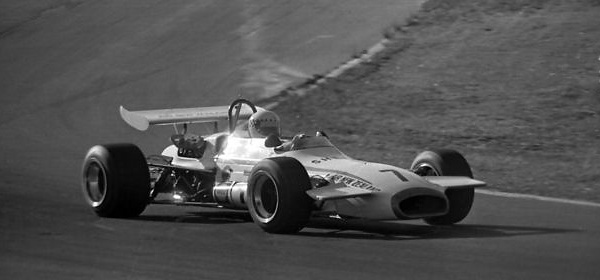
�
Graeme Lawrence in route to a second place finish in the Angus & Coote Diamond Trophy race at
�
Oran Park, Australia in June 1971. This was the second round of Australia's Gold Star Championship,
�
so it drew a very strong field of competitors. However, since Lawrence didn't carry an Australian racing
�
license he wasn't eligible to win championship points. (Photo by Lynton Hamer. Used by permission.)
�
�
 �
�
�
�
�
Graeme Lawrence was sponsored by Air New Zealand, so he repainted the BT29 in their white�
and blue color scheme, just as it appears today. He also procurred and supplied a�
second engine. Over the course of the year, he would switch back and forth between a�
1.6L Lotus Twin Cam engine and the 1.85L Cosworth FVC engine as rules and competition required.�
�
Lawrence was successful with his Brabham right from the start, with victories in both the�
Singapore Grand Prix and the Kuala Lumpur Grand Prix. For the Japanese Grand Prix he�
re-installed the 1.85L Cosworth FVC engine and placed fourth. At that point, he put the�
car up for sale, but when the sale fell through Lawrence decided to enter the second round�
of the Australian Gold Star Championship at Oran Park - where he placed second. (Race winner�
Max Stewart had a two liter Ford engine with Waggott Engineering 16-valve cylinder head in�
his Rennmax "Mildren" racecar. The quickest Formula 5000 car finished third.)�
�
�
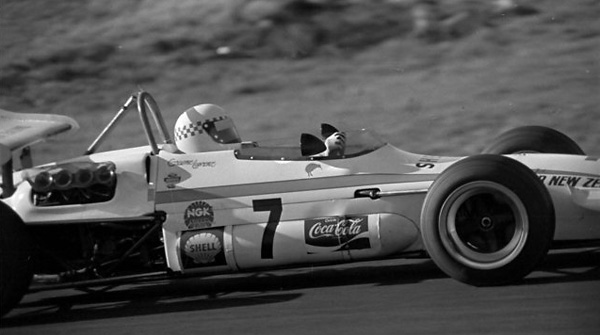
�
Graeme Lawrence set a new lap record at Oran Park while fighting to come from behind
�
after spinning out. He finished second. (Photo by Lynton Hamer. Used by permission.)
�
�
Lawrence reinstalled a Twin Cam engine in his Brabham BT29 for the Malaysian Grand Prix�
of September 5th. After that, the Australian Grand Prix was the last big race for Lawrence�
in 1971 and his fourth place finish at Warwick Farm was a major success considering that five�
liter cars were in their element. He defeated five of the eight Formula 5000 cars entered.�
Round three of the New Zealand Gold Star Championship was icing on the cake. Lawrence won�
that last outing in the BT29 without trouble, then moved on to a five liter Lola. �
�
Graeme Lawrence / 1971 Southeast Asian Races
�| Date | Race Name | Venue | Results | Comments | |
| 4/11 | Singapore Grand Prix | Thomson Road circuit | 1st of 7 | ||
| 4/18 | Kuala Lumpur Grand Prix | Shah Alam circuit | 1st | ||
| 5/3 | Japanese Grand Prix | Fuji Intl. Speedway | 4th of 14 | ||
| 6/27 | Angus & Coote Trophy | Oran Park AU | 2nd of 16 | (spun. Set lap record coming back!) | |
| 9/5 | Malaysian Grand Prix | Shah Alam circuit | 5th | (spun. Quickest practice & race laps.) | |
| 10/3 | NZ Gold Star Ch. - Rnd.1 | Pukekohe NZ | 2nd | ||
| 11/21 | Australian Grand Prix | Warwick Farm AU | 4th of 21 | (fastest 2L car & just 4s off podium!) | |
| 12/3 | NZ Gold Star Ch. - Rnd.3 | Levin NZ | 1st | (set fastest race lap, at 45.7s) | |
Later History and Restoration
��
After Graeme Lawrence's use, the BT29 was updated and raced by several owners. At�
one point it was powered by a Fiat engine, then a Cosworth BDA, and reportedly it�
was even set up as a Formula Ford for awhile. The original bits were separated, and�
then ultimately hunted down and put back together. Around 1986, David Sharp did a�
meticulous job on the restoration of BT29-23. Sharp also acquired and restored�
Graeme Lawrence's Lola T332 Formula 5000 racecar. When health issues ended Sharp's�
racing, he put both cars up for sale. Sharp last raced the BT29 in 1993, then it�
sat unused for over a decade. Murray bought the T332 and raced it for awhile, then�
sold it and bought the BT29. �
�
�
BT29-23 is currently presented with a Cosworth FVC engine (with 681F6015-A engine block)�
that Murray purchased from a seller in Sweden. Murray also has a Brian Hart built "416B"�
(1970) motor, which is similar to the 1600cc Twin Cam Lawrence also used.�
�
Murray maintains the Brabham himself, with the assistance of his friend Rod Collingwood.�
He explains that Rod is "the quality control guy" and also his preferred engine builder. �
�
Please support the sponsoring companies who make www.BritishRaceCar.com possible, including:
� �
 �
�
�
�
About Cosworth FVA and FVC Engines
��
At the instigation of Colin Chapman, Ford Motors commissioned Cosworth to design a three liter�
Formula One engine. The agreement stipulated that to prove Cosworth's proposed cylinder head�
design a four cylinder Formula Two cylinder head should first be developed for an existing�
Ford engine block. Formula Two rules stipulated that mass production engine block castings�
be used; Cosworth selected Ford's existing "120E" engine block.�
�
Keith Duckworth started designing the Cosworth FVA (Four Valve type A) cylinder head in July 1965,�
and a prototype was ready for bench testing by March 1966. The FVA engine first raced at a�
small club event in July.�
�
Duckworth's key design idea for the project has come to be called "barrel turbulence." Simply put,�
inlet flow is largely aimed at the far side cylinder wall to produce a circular motion in the�
plane of crankshaft rotation. This rotation increases in velocity during the compression stroke.�
Cosworth selected the maximum bore size feasible within the 120E engine block, and then calculated�
the stroke that would bring displacement right up to the 1.6L Formula Two class limit. With a bore�
of 3.375" (85.725mm) and a stroke of 2.722" (69.139mm), displacement came to 1596cc and bore-to-stroke�
ratio was 1.24:1. Woods type tappets were used. (These are tappets located above valvesprings to�
facilitate oil-cooling.) Lucas fuel injection and transitorized ignition were presupposed, and a�
(nearly) fully skirted piston design was selected. Cosworth planned to use a tri-y (4-2-1) header.�
In testing, a rather long overall length was found to be critical to performance.�
�
The Cosworth FVA proved a great success. FVA powered cars won four of five Formula Two championships�
between 1967 and 1971, and won about 78 percent of races in those years. In 1972 the Cosworth FVA was�
made obsolete by its successor: Cosworth's BDA (Belt Drive type A) engine.�
�
The Cosworth FVC engine is a stroked version of the FVA for classes with a larger displacement�
limit.�
�
�
�
Features and Specifications
�| Engine: | �Ford FVC 16V DOHC four cylinder engine.�
(681F6015-A block.)�
Lucas mechanical fuel injection.�
Pipercross foam air cleaner.�
Pertronix Ignitior breakerless ignition module.�
Electronic rev limiter (set at 9000rpm).�
Bosch Super Sports inductive core spark plug wires.�
| �
| Cooling: | �original style copper and brass radiator, with integral oil cooler. | �
| Exhaust: | �custom fabricated four into one header. | �
| Transaxle: | �Hewland FT200 five speed.�
Metalastic (rubber) drive donuts. | �
| Front Susp.: | �unequal length wishbones.�
Brabham proprietary magnesium uprights.�
Armstrong non-adjustable coilover shock absorbers.�
Faulkner helper springs.�
Adjustable anti-sway bar.�
Brabham proprietary steering rack. | �
| Rear Susp.: | �inverted lower wishbones, single top links, and twin radius arms.�
Brabham proprietary magnesium uprights.�
Armstrong non-adjustable coilover shock absorbers.�
Adjustable anti-sway bar. | �
| Brakes: | �(master) dual Girling master cylinders with remote reservoirs and adjustable bias bar. � (front) Girling AR Mk3 aluminum dual-piston calipers, and solid rotors, � (rear) Girling AR Mk3 aluminum dual-piston calipers, and solid rotors. | �
| Wheels/Tires: | �Brabham magnesium racing wheels (13x10 front, 13x12 rear). � Avon racing tires (10.0/22.0/13 front, 13.0/23.0/13 rear). | �
| Electrical: | �Odyssey PC535 battery (200CCA, 12.0#).�
Tilton Super Starter XLT. | �
| Instruments: | �(left to right)�
Smiths dual fuel pressure (0-160psi) and water temperature (30-120C) gauge,�
Smiths Chronometric tachometer (0-10000rpm) with tattletale, and�
RaceTech Design dual oil pressure (0-160psi) and oil temperature (30-120C) gauge. | �
| Fuel System: | �optional-equipment high capacity (~11 gallon) Brabham fuel tanks.�
Lucas high pressure electric fuel pump, for starting.�
Lucas high pressure belt-driven fuel pump, for racing.�
Facet (Bendix style) low pressure electric fuel pump, for filling the make-up tank.�
Kinsler diaphragm type adjustable fuel pressure regulator.�
| �
| Safety Eqmt: | �Willans 6-point cam-lock safety harness.�
Moto-Lita steering wheel.�
Talbot mirrors.�
Chubb-Flameguard fire extinguisher.�
| �
| Weight: | �480 Kg (1058 lb) dry.�
| �
Engine Installation
��

�
Ford FVC 16V DOHC four cylinder engine.
�
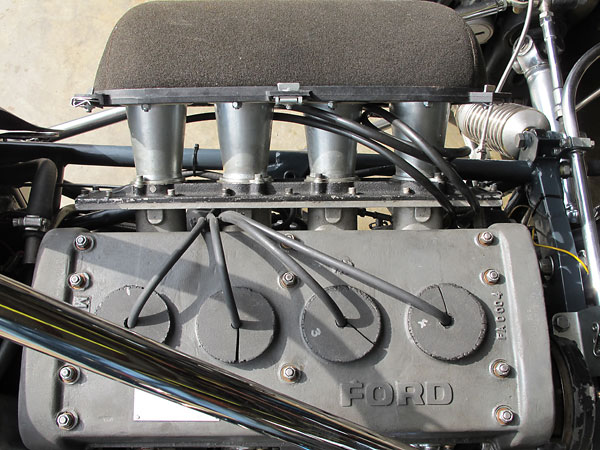
�
With their longer stroke (77.6mm vs. 69.4mm) and thus larger displacement (1790cc vs. 1598cc),
�
Cosworth's FVC engines produced about twenty horsepower more than the preceding FVA model,
�
as used in Formula Two racecars. The two engines were rated 235bhp and 218bhp respectively.
�
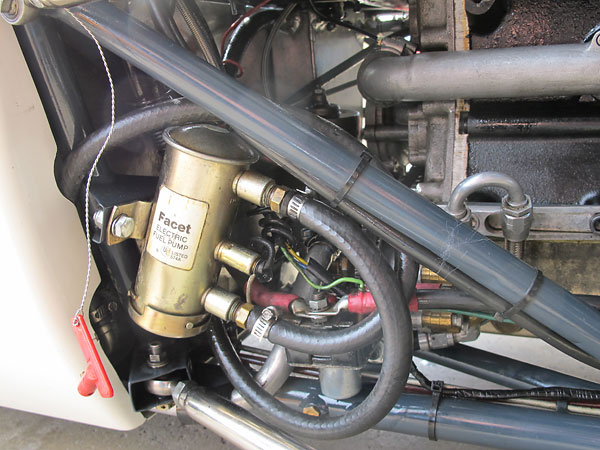
�
This Facet electric fuel pump just fills the aluminum "make-up tank" which you can just see in the
�
background here. It's a low pressure pump, and the fuel injection system requires high pressure.
�

�
In this view, you get a better view of Murray's fuel make-up tank. Also, you can see that,
�
as on so many racecars of its era, engine coolant and oil are routed through frame tubes.
�
(A dual purpose radiator/oil cooler and an aluminum oil tank are located under the nose cone.)
�
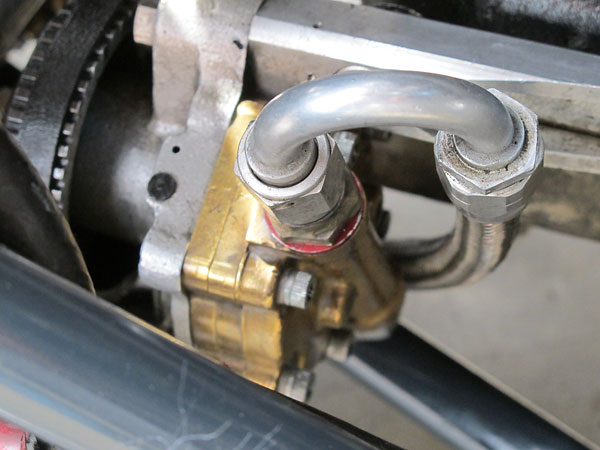
�
Engine driven high pressure fuel pump. (These produce about 100psi.)
�

�
Since the engine driven fuel pump won't develop enough fuel pressure to start the engine,
�
an electric high pressure fuel pump is also needed. Actually, the two pump mechanisms
�
are similar, except the "electric" one is driven by a Lucas windscreen wiper motor!
�
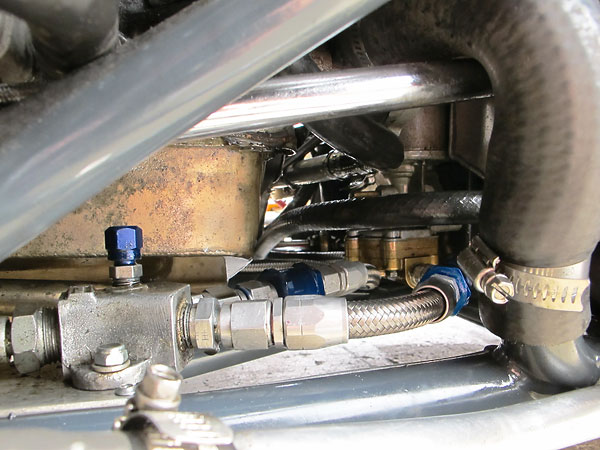
�
These Lucas fuel pump mechanisms were originally developed for Triumph "2.5 PI" cars
�
(i.e. "2.5 liter petrol injection".)
�

�
This Kinsler diaphragm type adjustable fuel pressure regulator is on the return line between
�
the fuel injection metering unit and the make-up tank. (Fuel supply lines are shown above.)
�
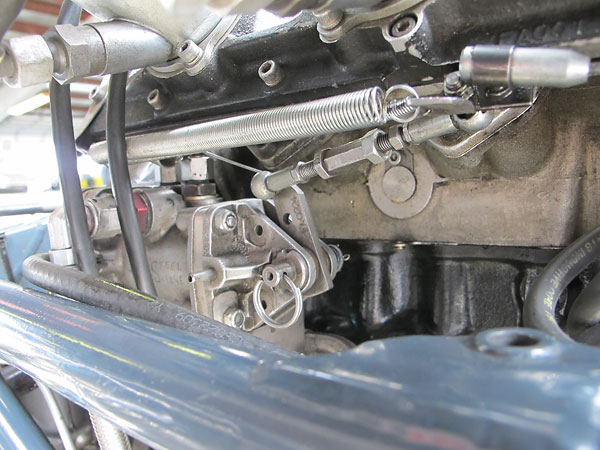
�
The throttle cable (upper right corner) pulls open the sliding four-aperture throttle plate.
�
It's also connected via linkage to the fuel injection metering unit. In fact, the base of the
�
connecting lever has a cam profile selected or modified to suit fuel mixture requirements.
�

�
Lucas fuel injection metering unit.
�

�
Left: an alternator. Right: belt drive for the Lucas mechanical fuel injection metering unit.
�
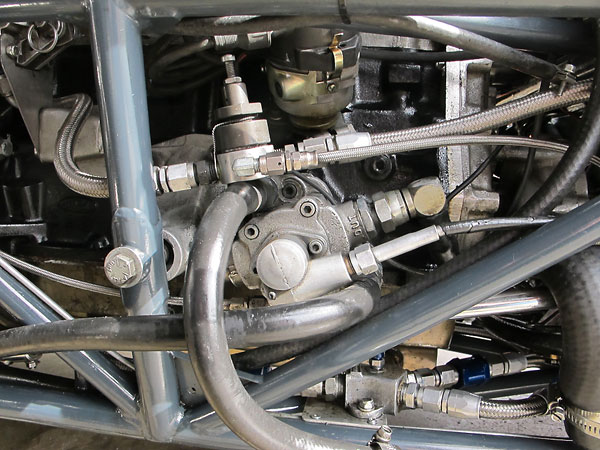
�
A mechanical tachometer is driven by cable off the end of the oil pump. (The back end of
�
the exhaust camshaft might have been used if an alternator weren't already fitted there.)
�
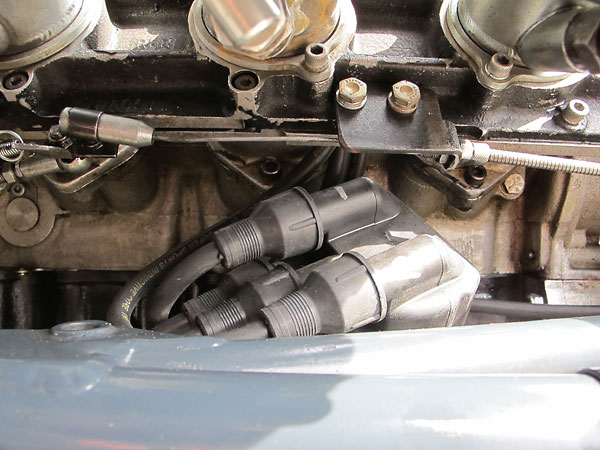
�
A Lucas Opus ignition system would be period correct for this engine, but service parts are
�
scarce and they're famously unreliable (at least compared to more modern ignitions.) Murray is
�
currently using a Pertronix Ignitor breakerless ignition module within a conventional distributor.
�
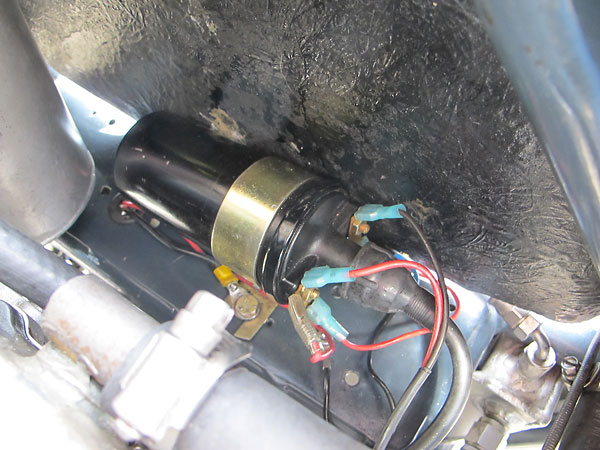
�
Red and black leads (at top of picture) route to the Pertronix Ignitor. What are the other extra
�
connections to this ignition coil? They're your clue that an electronic rev limiter is in use.
�
Murray generally shifts at 8000rpm, and has his rev-limiter set at 9000rpm.
�
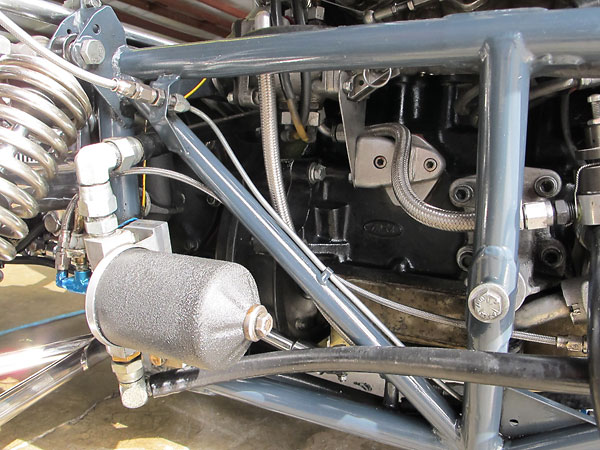
�
Engine oil filter.
�
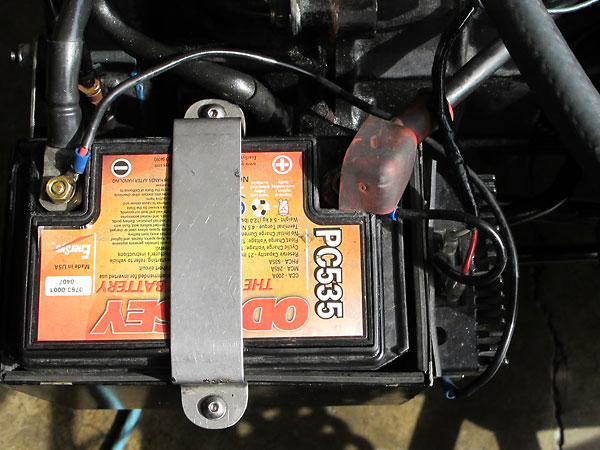
�
Odyssey PC535 battery (200CCA, 12.0#).
�

�
This electronic box is a transformer that converts AC to DC power.
�
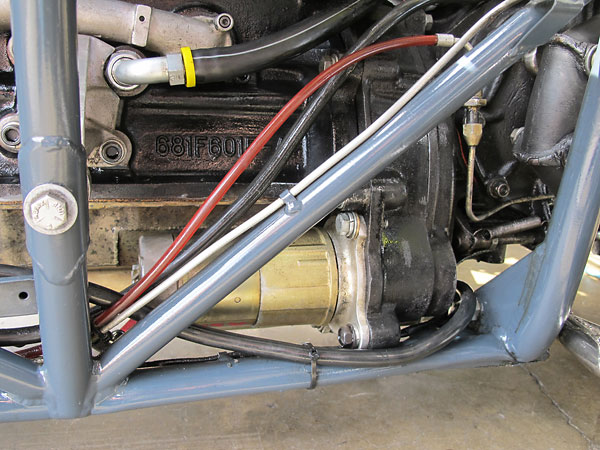
�
Tilton Super Starter XLT. (681F6015-A engine block.)
�
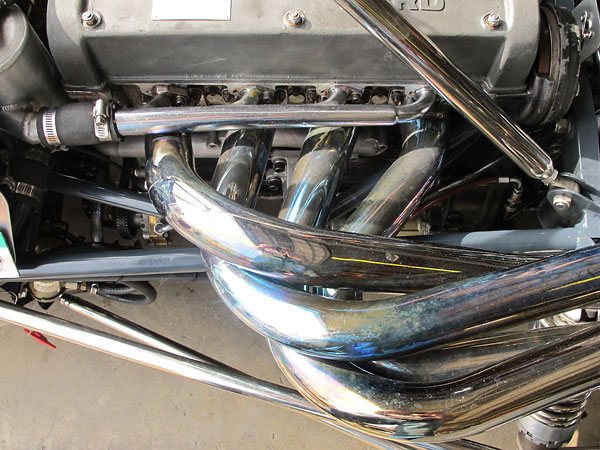
�
These headers are the same size as what Murray received from Sweden. They performed
�
well when dynomometer tested, so Murray decided to duplicate their dimensions.
�
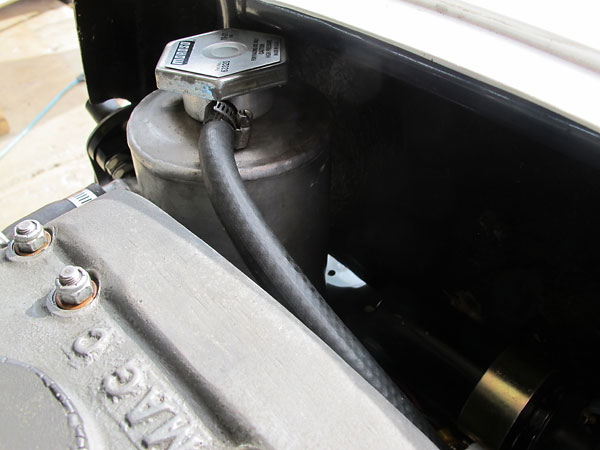
�
This coolant header tank is more than just a reservoir: coolant swirls within it
�
and the swirling action helps remove vapor (steam) bubbles.
�
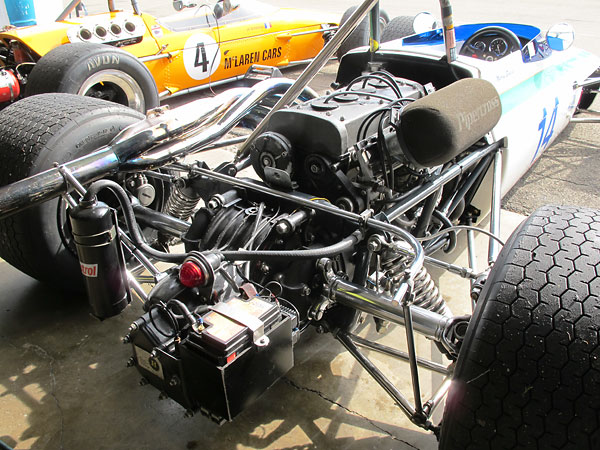
�
Brabham frames were fabricated by Arch Motors and their bodies were made by Specialised Mouldings.
�
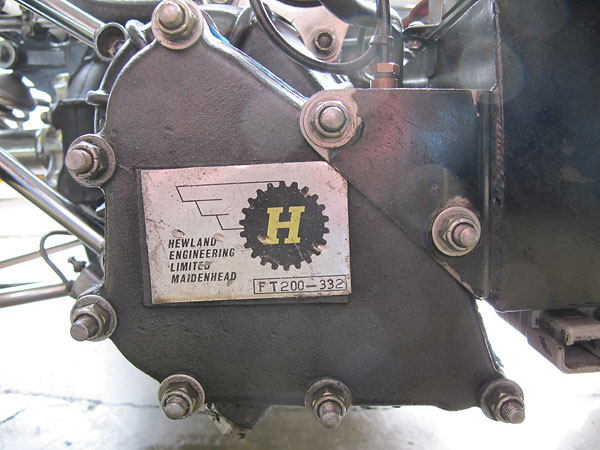
�
Hewland Engineering Limited, Maidenhead - FT200-332.
�
Hewland built over 2000 of these tough little transaxles.
�
�
Front Suspension / Etc.
��
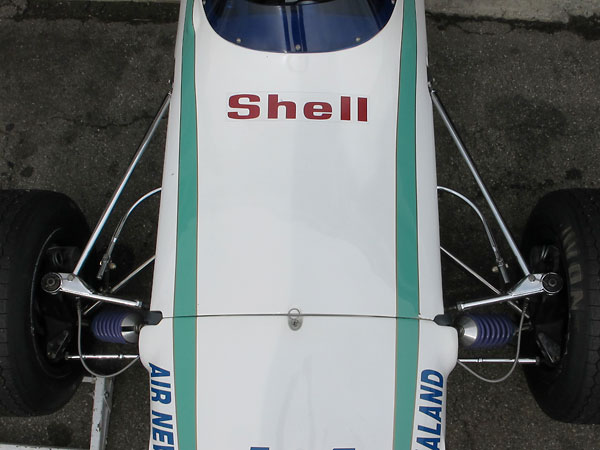
�
The rear leg of the upper A-arms are braced back to the cowl. Brabham Grand Prix cars had been
�
built this way since their introduction in 1962 but for the junior classes narrow-base A-arms had
�
been tried (e.g. on the Brabham BT21) and abandoned (on the Brabham BT23).
�
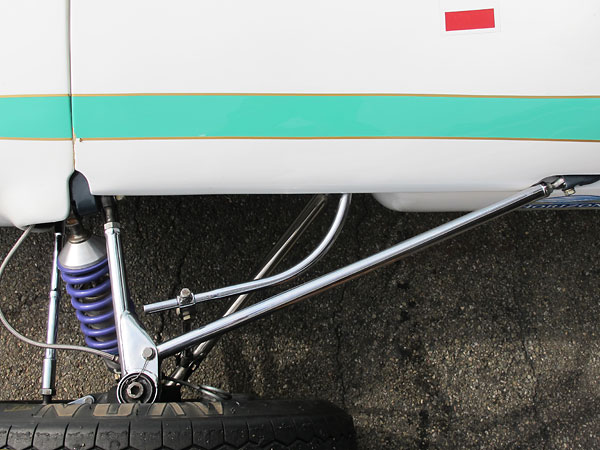
�
The conventional wisdom is that wide-based A-arms offer reduced vibration during hard braking.
�
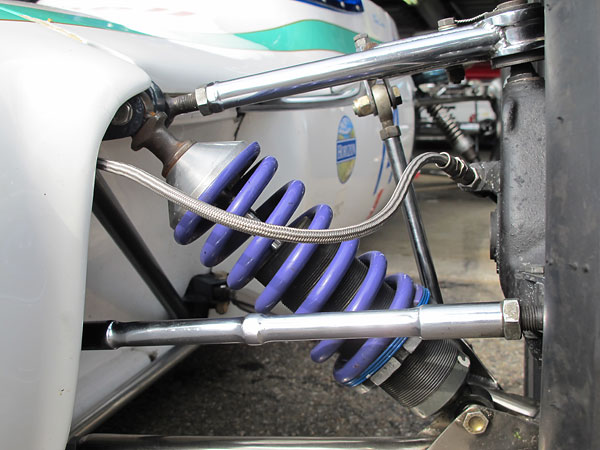
�
A thin Faulkner helper spring prevents the main spring from rattling loose when the suspension
�
is at full droop. Otherwise, it has little effect because its spring rate is only 4lbs/inch
�
(so most of the time it's fully compressed to about ~8mm thickness.)
�

�
After passing throught the radiator, air exhausts to the sides behind the suspension. On both
�
BT29 and BT30, the front bulkhead and footbox were made narrow to maximize cooling airflow.
�
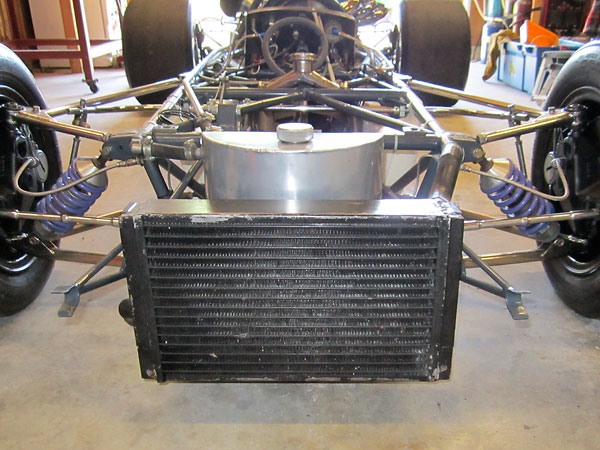
�
Original style copper and brass radiator. (Photo: Murray Sinclair. Used by permission.)
�

�
An oil cooler is integrated into the radiator assembly. (Photo: Murray Sinclair. Used by permission.)
�
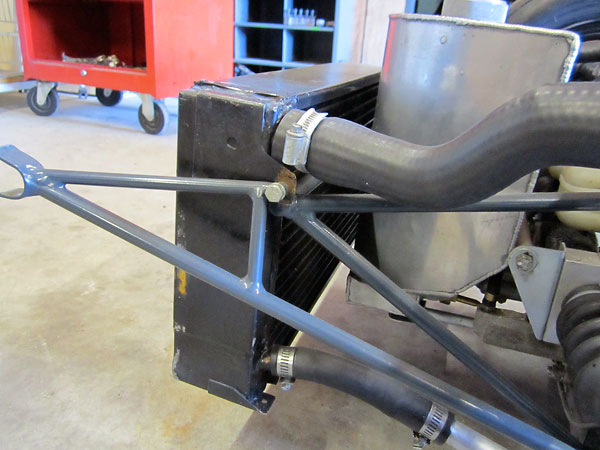
�
Lightweight tubular structure to support nose & front wings. (Photo: Murray Sinclair. Used by permission.)
�
�
IMPORTANT ANNOUNCEMENT
�
BritishRaceCar.com will have to cut back plans for continued growth if we can't find more financial support.
�
If you like what you've found here, and you want to see more, please click here and follow the instructions.
�
Readers like you keep BritishRaceCar.com online and growing through voluntary financial contributions.
�
Rear Suspension
��
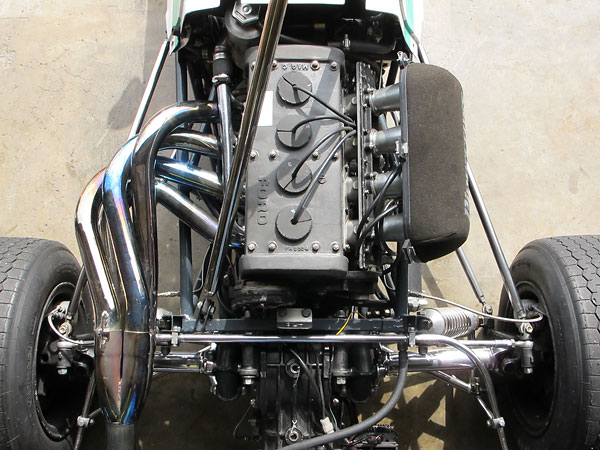
�
Power is transferred from the Hewland FT200 five speed through Metalastic (rubber) drive donuts.
�
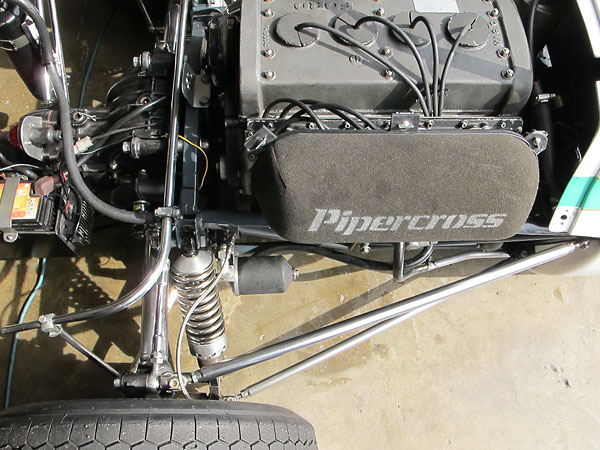
�
Coilover shock absorber, an inverted lower wishbone, a single top link, and twin trailing links.
�
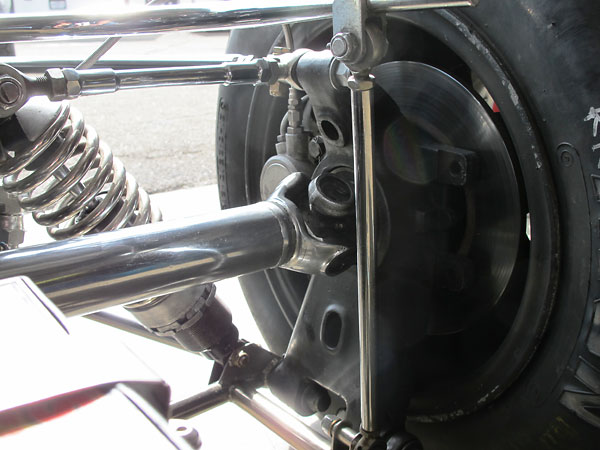
�
Brabham proprietary magnesium uprights.
�
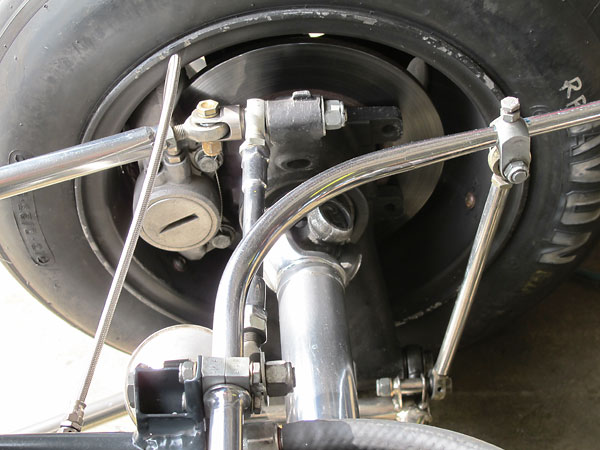
�
Adjustable anti-sway bar mounted on aluminum pillow blocks.
�
�
Interior
��

�
This paint scheme is very similar to the livery Graeme Lawrence used in 1971, but in that era this
�
car had an untinted windscreen and Vitaloni "Sebring" style (low profile, black plastic) mirrors.
�
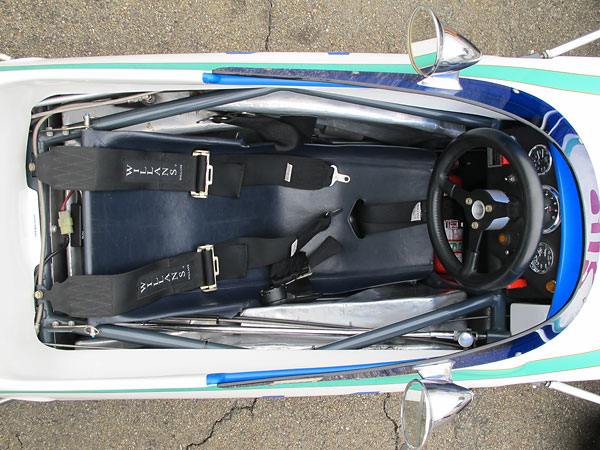
�
Fiberglass seat and Willans six point cam-lock safety harness.
�

�
Murray says he finds the Brabham BT29 cockpit to be surprisingly roomy and comfortable.
�
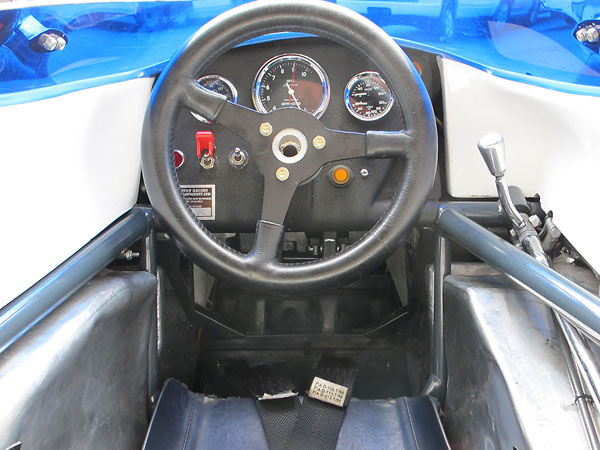
�
Designed to wrap around various frame tube, these elaborately fabricated aluminum fuel tanks gave
�
BT29-23 the capacity (~11 gallons) to complete endurance races without pit stops. These are NOT
�
similar to the tanks on Brabham BT30 Formula Two racecars. Formula Two rules mandated fuel cells
�
with rubber safety bladders, so BT30 tanks were more simply shaped and mounted further outboard.
�
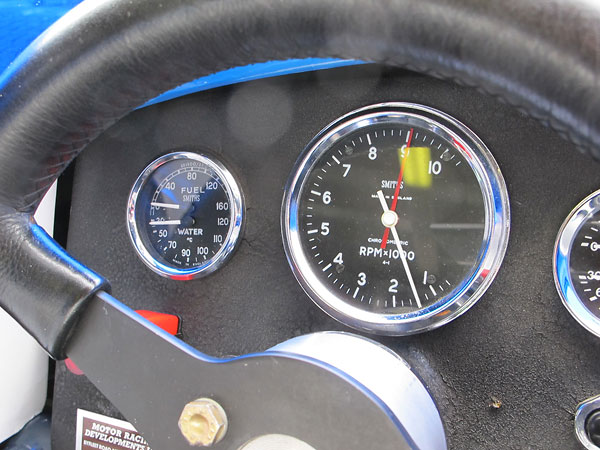
�
Smiths dual fuel pressure (0-160psi) and water temperature (30-120C) gauge, and
�
Smiths Chronometric tachometer (0-10000rpm) with tattletale.
�
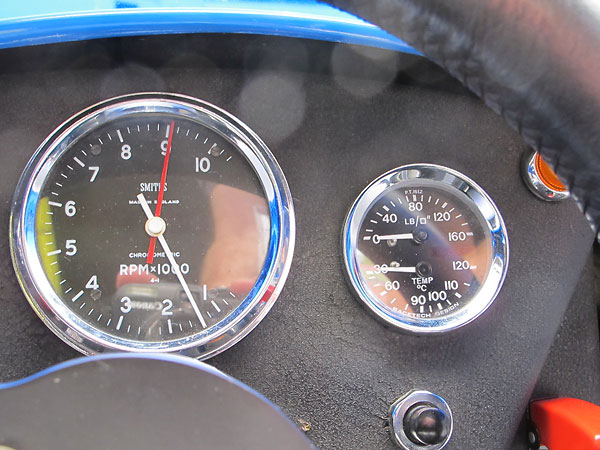
�
RaceTech Design dual oil pressure (0-160psi) and oil temperature (30-120C) gauge.
�
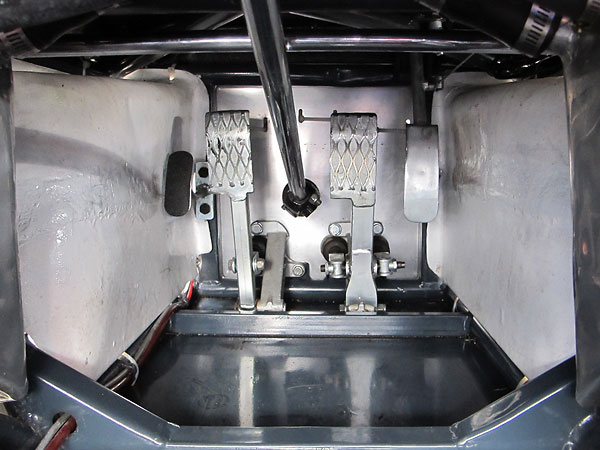
�
The Brabham frame is considerably stiffened by its steel floorpan. Usually BT29s also have a brazed-on
�
steel sheetmetal front bulkhead, but this particular car appears to have an aluminum bulkhead.
�
�
Exterior
��
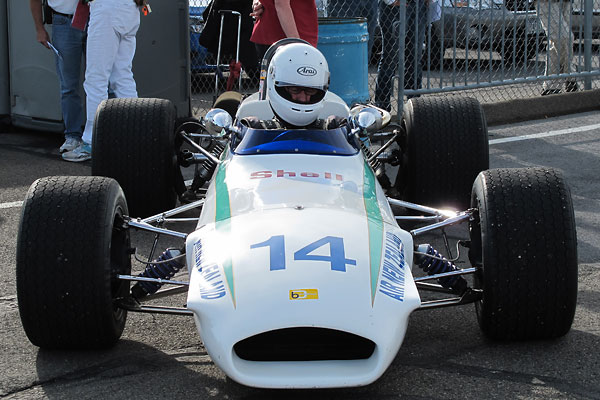
�
Murray Sinclair's Brabham BT29 racecar wore racing number 14 and Air New Zealand / Shell Oil
�
livery when Graeme Lawrence drove it in the 1971 Australian Grand Prix.
�

�
Murray Sinclair describes the Brabham chassis as "very progressive" and "easy for amateur
�
drivers to drive well". The BT29 is also reckoned to be an especially strong, serviceable car.
�
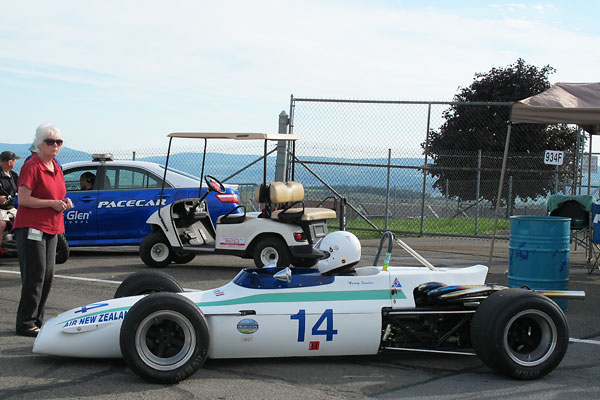
�
This is a later engine cover, as used on Brabham's BT36 model, circa 1971.
�
Original BT29/BT30 style engine covers slope downward all the way back.
�
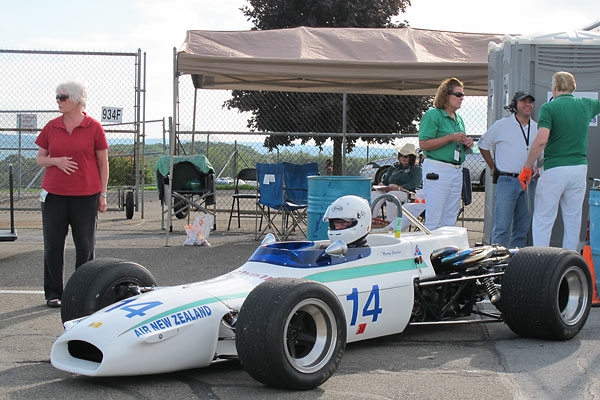
�
With rear wing completely removed and with only the vestiges of front wings
�
the car has less aerodynamic drag and is thus faster in a straight line.
�
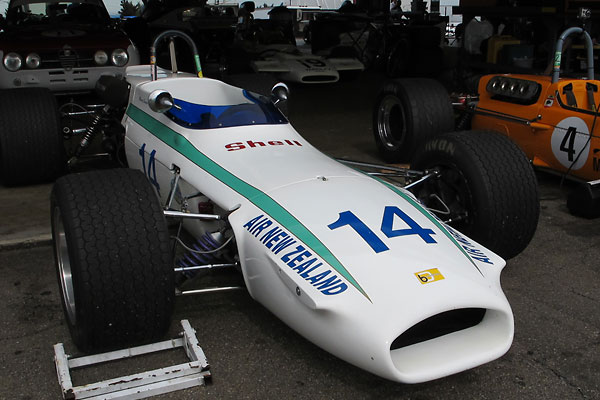
�
That's right... even though it has lost its wings through evolution, this kiwi really flies!
�
�
Except where explicitly noted to the contrary above, all photos shown here are from�
September 2011 when the car appeared at The US Vintage Grand Prix at Watkins Glen.�
Photos by Curtis Jacobson for BritishRaceCar.com. Copyright 2011. All rights reserved.
�
| If you liked this article, you'll probably also enjoy these: | �|||||
 | �
Brad Baker '69 Brabham BT30 | �
 | �
Michael Snowdon '72 GRD 272 | �
 | �
Phil Mauger '73 McLaren M23 | �
| You're invited to discuss anything you've seen here on The British Racecar Motorsports Forum! | �|||||
�
Notice: all the articles and almost all the photos on BritishRacecar.com are by Curtis Jacobson.
�
(Photos that aren't by Curtis are explicitly credited.) Reproduction without prior written permission is prohibited.
�
Contact us to purchase images or reproduction permission. Higher resolution images are optionally available.
�

 �
�